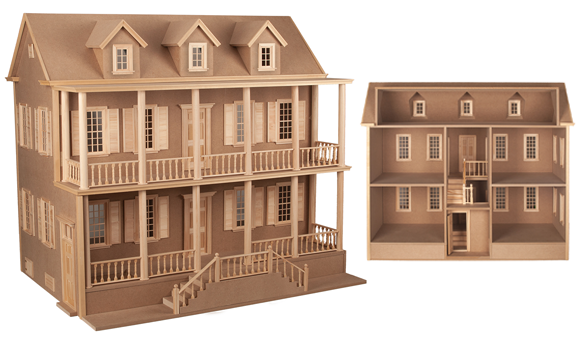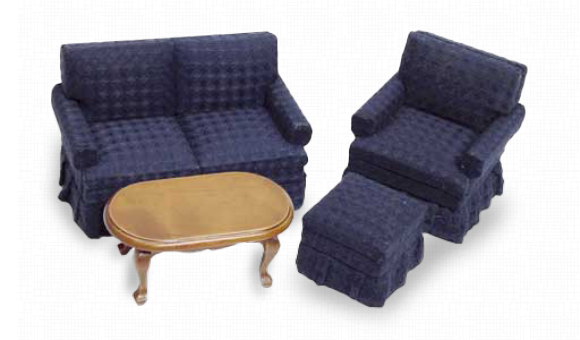The ultimate in finishing a dollhouse or miniature project is applying the appropriate dollhouse trim. Victorian styles use various fancy trims together for decorating both the exterior and the interior of the house. While Colonial homes have less trim on the exterior, they often use more elaborate trim on the interior than the Victorians do. Williamsburg is a good example. Study architectural books, period interiors and styles of homes for ideas. Many of these can be found in your local library. Then use your own imagination.
Decorative apex trim, that fits perfectly into the apex of the roof, was very popular during the Victorian era. The apex is the point at which both halves of the roof meet.
Another popular trim used on Victorian houses was the decorative porch trim that fits in the corners by the porch post. Many porch trims matched the apex trim. Corbel brackets can be used on the porch as post brackets, or in archway corners on the interior of the house. The Post Bracket and Eaves Bracket can be used as post brackets on the porch, under eaves and bay windows, or other areas on the exterior.
Corner moulding, also known as angle moulding, is used to finish off the exterior corners of the dollhouse. It can also be used as a roof cap.
Channel moulding is used to trim off the back edges of the walls and floors on a back opening dollhouse. The 3/8" fits over 1/4" plywood, and the 1/2" will fit over 3/8" plywood. It is easier to cut all interior mouldings before you paper or paint the walls. This way you will not get finger prints on the paper or paint while you are measuring. Wondering how to trim a window interior or install a dollhouse door, window, and baseboard trim? Read on.
Interior Trim
Wainscotting
This method of trimming walls has wallpaper on the upper portion of the wall, with wood paneling and fancy trim on the lower portion. The two sections of the wall are divided by a chair rail. Sections of sheet wood flooring, or wood with fancy moulding designs, may be used for the wood paneling.
- Measure 3" from the floor and draw a line on the wall.
- If you want a fancier, heavier and more formal ceiling moulding, add two or three pieces of different moulding on top of each other.
- Experiment with different mouldings, until you get the look you want. Then miter and glue around the top of the wall (see Miter directions in the Shingles Section).
- There are many different sizes and designs available in fancy trims. The trim on my Victorian porch (featured on Porches Across America has three different pieces of moulding glued together. I did this to achieve a particular look around the edge of the roof and on the top edge of the walls.
Chair Rail
This section concerns only a chair rail design on the wall.
- Draw a line on the wall 3" from the floor. Three inches is the standard height for chair rails, but you may change the height to suit your preferences. You may use a combination of wallpaper and paint with the chair rail in between, or you may just paint both sections of the wall separated by the chair rail. Another method is papering between the ceiling and the chair rail, and then adding a companion wallpaper between the chair rail and the floor.
- Paint or stain the chair rail, ceiling moulding and baseboard.
- Glue the chair rail along the line, the baseboard along the floor, and the ceiling moulding (where else?) at the top of the wall.
Window Interior Trim
Windows can be trimmed on the interior with either door and window casing or strip wood. Many of the windows come with window trim already mitered to fit the interior. If your windows do not include interior trim, you can use one piece of 18" trim for standard windows. Interior trim is applied after the walls have been finished. The interior trim covers the interior frame of the window, as well as the opening space between the window and the dollhouse. Glue the interior trim onto the frame and the wall. Be sure that the window is centered in its opening, so that the spaces are equal and will be covered by the trim.
To determine how much moulding you will need to trim your windows, add the width of the trim moulding to each end of the window's interior measurements. For example: if the width of the window is 3" across the top of the interior frame, and the trim is 3/8" wide, add the 3" + 3/8" + 3/8" = 3 3/4". The top and bottom pieces will measure 3 3/4" on the outside edge and 3" on the inside edge with a 45° miter between. Now, measure the side pieces the same way.
One way to apply the interior trim is to cut a pattern of the window opening of the interior window frame. Then, lay the trim on the pattern, mark the inside corners on the trim and make a 45° miter to the top on both ends.
You can also measure and mark the trim right on the window frame after the window has been glued in. The corners can be mitered using either a miter box and saw, a German miter tool, or a chopper. They are all set for 45° miters.
I have found that when I use the German miter tool, it is best to cut one end of the piece of trim from the front. Then the next piece of trim that it matches will fit better, if you turn the piece of trim over and cut it from the back. The pressure from the tool seems to cut on a bias. Therefore, if you cut the miters on the top and bottom pieces from the front, cut the miters for the side pieces on the back of the trim. Then they should fit nicely. Otherwise, there is a slight space in the miter fit.
The mitered interior trim is the most elegant finish for a window. You should definitely use the mitered trim when the window is not dressed and will be exposed.
The simple or square trim method is often used when you are going to put curtain rods on the trim, as it is easier to attach them to a solid piece of wood rather than a miter cut. Also, when you use cornices and drapes, this method is sufficient as the trim will not show. With the straight cut you can also add a window sill. For this method, cut the top and bottom pieces so they have square ends. Then, cut the side pieces to fit inside the top and bottom pieces.
Interior Door Trim
Interior door mouldings have three pieces. Installing door trim is similar to installing window trim, in that the top piece is measured just like the windows and is mitered on both ends.
Archways
Archways will take three pieces of trim: one piece of trim across the top and one down each side just like an interior door. However, you will trim both sides of the wall in each room. The center piece that lies between the pieces of trim, covering the width of the plywood, is cut lengthwise with square ends. The same trim can be used if it is the right width, or you may use a plain piece of strip wood the width of the plywood. Fancy corner trims can be used in the corners for Victorian-style rooms.
Wood Head Blocks
Wood head blocks are normally used on the corners of door frames with the door and window trim. The wood blocks can also be used on the exterior, side-by-side or spaced to create another fancy Victorian trim. They can be placed circle-by-circle or reverse every other one in order to have a circle then plain, and so on.
Ceiling Moulding and Outside Trim Miters
Miters
The miter cut is used when two pieces of trim moulding join at an inside corner, an outside corner, or around a window or a door. Use the Miniature Miter Box and razor saw blade and knife handle for cutting the miter. These can be purchased as a set. Make sure when you are cutting that you hold the piece of moulding trim secure in the miter box.
First, decide how much moulding trim you will need by measuring the walls to be used in each room, or area to be trimmed. Round fractions to the nearest inch. Always mark the piece of moulding trim at the longest point of the 45° angle. The mark should be at the cut opening on the miter box for the longest point of the piece of moulding being cut.
Usually, I stain or paint all of my trim before cutting it to fit the walls. After cutting, you might want to restain the cut edges of the stained trim, so that no raw edges will show. This is important, because if the fit is not quite exact, you will not be able to restain over the glue. If the trim is painted, you can wait until you have glued the pieces together and onto the wall, before you touch them up, since you can paint over glue.
Outside Corner Miter
- Place the piece of moulding upside down in the miter box (top of moulding sitting on the base of the box), with the wrong side facing the side of the miter box.
- Cut from left to right at a 45° angle. The right side piece will be the piece on the right after you have made the miter cut.
- For the left side piece, place the moulding in the same position and cut from right to left at a 45° angle. The piece on the left will be the left side piece.
- Match the two pieces together. If the pieces don't fit exactly, sand with an emery board or a piece of fine sandpaper.
- When you are satisfied with the fit, glue on the trim molding. You now have an outside corner miter. I used this type of miter on the dentil moulding under the roof edge on one of my porches.
Inside Corner Miter
This type of miter is used for most cornice moulding.
- Measure the moulding and mark the miter cut on the bottom of the moulding trim.
- Place the moulding upside down in the miter box. Pretend that the bottom of the miter box is the ceiling of your dollhouse, and that the back is the wall.
- For the right side piece, cut the moulding from left to right. The piece on the left will be the right side piece of the cornice.
- For the left side piece of the cornice, cut the moulding from right to left. Use the piece on the right after cutting.
- Put the two pieces together to see if they fit. As before, you may need to sand a little to get a better fit.
- When you are satisfied with the fit, glue the pieces in place.
- If you have three walls, cut the two side pieces first. Measure the longest points on each end of the middle piece and miter both ends.
Coping Method
The Coping Method is sometimes used for cornice or trim mouldings for ceilings at an inside corner. One piece (usually the right piece) is cut to butt up to the corner. The other piece is cut to fit the profile of the trim moulding. The piece that is cut to fit the contour of the trim is usually sawed with a coping saw in what I call real size. However, in miniature, this can be done with your miter saw or with an X-Acto knife.
- Place the trim moulding right side up in the miter box. Pretend that the back of the miter box is the wall of your dollhouse.
- Cut from left to right at a 45° angle.
- You will see that the design of the trim is exposed and can be used as a guide line to cut at a 90° angle to the face of the trim moulding.
- You now have a duplication of the design of the moulding, and it should fit over the other piece of the moulding.
Baseboard or Base Moulding Miter
To cut the moulding trim for baseboards, place the moulding right side up in the miter box. Pretend the bottom of the box is the floor of your dollhouse, and that the back is the wall. Measure your moulding the same as you did for the ceiling mouldings.
Inside Corner Baseboard Miter
- For the left side piece, cut a 45° angle from left to right. The piece on the left will be the left side piece.
- Cut a 45° angle from right to left for the right side piece. After cutting, the piece on the right is the right side piece.
- Place the two pieces together to see if they fit. If they don't, sand lightly until the desired fit is achieved.
Outside Corner Baseboard Miter
- For the right piece of moulding, cut at a 45° angle from left to right. The piece to the right will be the right side piece.
- To get the left piece of the moulding, cut the moulding from right to left at a 45° angle. After cutting, the piece on the left will be the left side piece for the outside corner.
Splicing Moulding Trim
This method is used when you have run out of moulding and need to piece the moulding in order to finish the project. You can also use this method if the wall is longer than the length available for the moulding pieces.
- Pretend that the back of the miter box is the wall. Place the piece of moulding in the proper position (right side up for baseboard and upside down for ceiling) in the miter box. Cut both pieces at 45° angles from left to right.
- Now you can overlap one piece over the other. It will hardly be noticed that you have spliced the two pieces of wood. This is called a scarf joint.
- If you are satisfied with the fit, glue the two pieces together. Then glue them on the wall.



